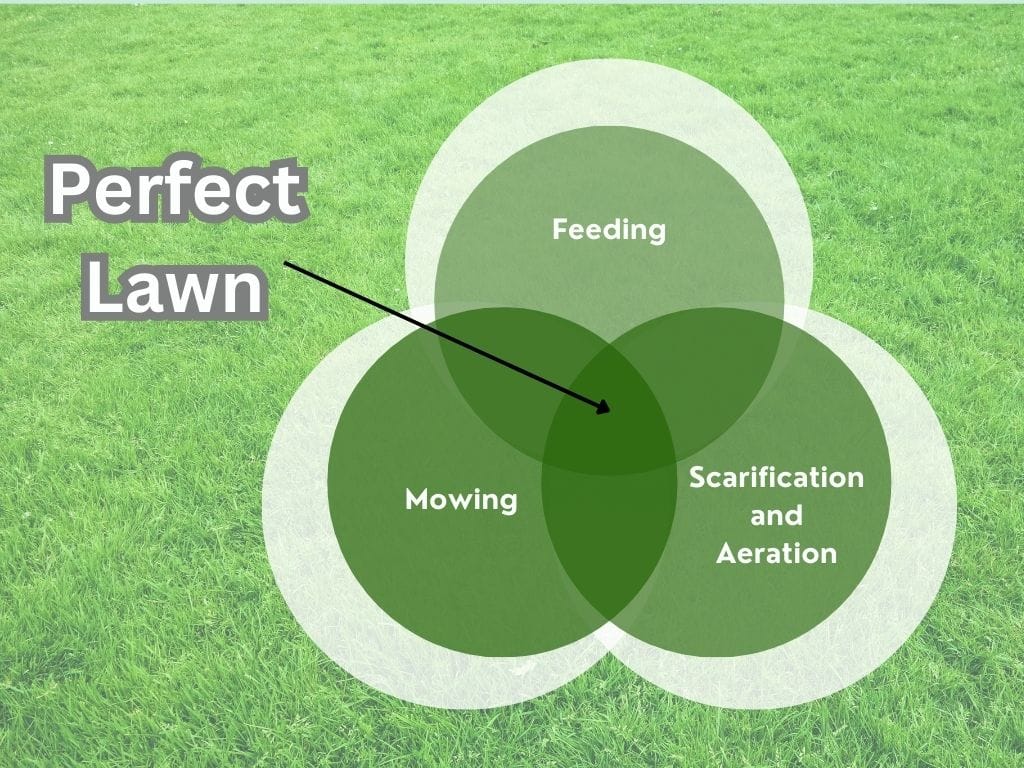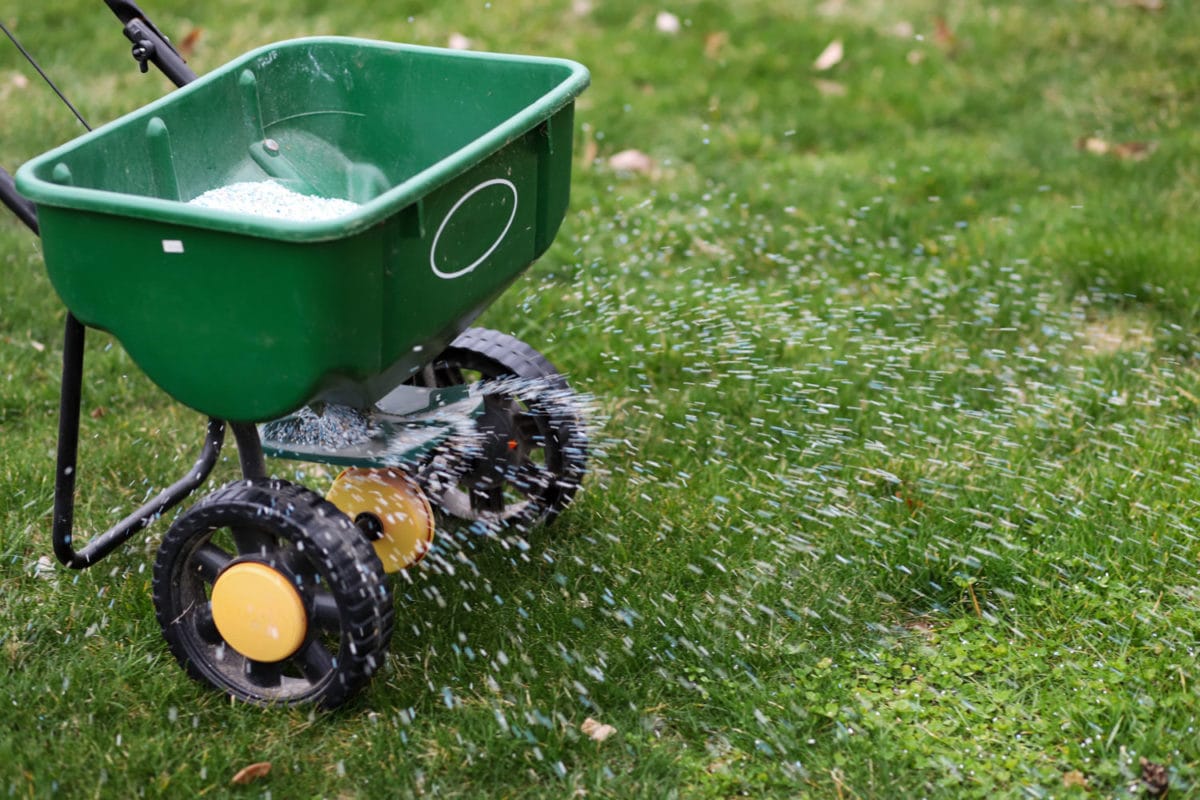I’m often asked about feeding lawns so here are the answers to my most frequently asked questions.
- How will feeding lawns improve your garden?
- What nutrients does a lawn need?
- What time of year is best for feeding lawns?
- What equipment is needed to apply lawn feed?
- Can I damage my lawn if I make a mistake with the feed?
- How to get the best results for the lowest cost.
- Simple rules for feeding lawns.
How Will Feeding Lawns Improve Your Garden?
Lawns are an important part of our gardens. In most cases, the lawn takes up a large proportion of the space. And whilst you probably don’t take too much notice of a healthy lawn, a poor quality lawn will make the whole garden – nay the whole property – look tired and unloved. On the other hand, a really well manicured, deep green and weed free lawn can create an unsurpassable wow factor – especially if it has stripes!
The key to having a wow factor lawn lies in a combination of factors, but one of the most important of all, is nutrition. Ensuring that your lawn has the right balance of nutrients throughout the changing seasons is key to its long lasting good looks.
When your lawn looks good, your garden looks good. And for a front garden, that also adds to the kerb appeal of your property. A great looking lawn will highlight the beauty of a well-clipped hedge, a colourful flower border and a beautifully landscaped patio. It will also detract from the odd weed in your shrubbery or a few oil stains on your driveway. It’s like magic!
Oh – and don’t forget that plant nutrients can move around in the soil. If you are feeding your lawn on a regular basis, your other plants will also benefit.

Working towards a perfect lawn involves a combination of factors: One of the top three most important things is feeding.
What Nutrients Does A Lawn Need?
Humans need a balanced diet of proteins, fats, carbohydrates, vitamins and minerals. Our bodies break complex molecules down into simple chemical elements and then use those elements as building blocks to provide energy and build muscles, repair wounds and make brain cells, enzymes and hormones.
Plant’s don’t have a digestive system. And so they need to be supplied with the basic building blocks for all the growth hormones, enzymes, and new cells they need for good healthy roots and leaves.
Those building blocks are: Nitrogen, Phosphorus and Potassium along with a raft of micronutrients such as iron and sulphur.
Most plant nutrients are available in small quantities in the soil. However, the proportions will vary according to the soil type, local weather conditions and land management. For example a clay soil that has had farmyard manure added to it every autumn for the last century will have a very different nutrient content to a sandy soil that has never been fertilised.
Gardeners and lawn lovers know that feeding lawns will provide the correct balance of nutrients for our grass plants all year round. The trick is knowing what to feed and when.
What Time Of Year Is Best For Feeding Lawns?
The best looking lawns are fed regularly throughout the year. Even in winter. But the balance of nutrients within the feed is adjusted to suit the season.
In spring and early summer, the soil is warm, there’s plenty of rainfall (at least there is here in Northern Ireland!) and the grass plants are determined to set seed. That means that the lawn grows as fast as a teenaged boy. And just like a teenaged boy – it’s always hungry.
The number one requirements for your lawn in spring time are nitrogen for cell building and a smidgeon of Iron. Iron is an important component of the chlorophyll that gives the lawn its green colour and allows the plants to make energy from sunlight. Your lawn also needs a balancing amount of Phosphorus and Potassium. Because, as we humans know to our peril, with a plentiful but unbalanced diet, living things grow big but not strong.
As autumn arrives, the plants sense that they days are getting shorter and they need to prepare for winter. That means slower growth above the ground – because young shoots are more susceptible to cold. But also more growth beneath the ground. Getting those roots down deep into the soil where the frost can’t reach them, and storing nutrients within them.
In autumn and winter your lawn will still be growing and it will still need nutrients. But at this time of year, too much nitrogen could result in soft, sappy growth that is vulnerable to disease and frost. So the feed you apply should have a smaller percentage of Nitrogen and higher percentages of phosphorus and potassium.
Do I Need Any Equipment For Feeding My Lawn?

If you have a tiny lawn and you are naturally very precise at spreading granular feed evenly over an area, you might get away without investing in any equipment. But honestly for anyone with a lawn thats bigger than 5 square metres, you MUST use a fertiliser spreader. Even more importantly – you must learn how to calibrate and use it properly.
If you plan to apply supplementary feeds such as seaweed tonic or humid acid (and I strongly recommend that you do), invest in a garden sprayer too. Please please please, don’t use the same sprayer for lawn feed and weedkiller unless you are super-confident that you can wash it out really well between applications. Can you imagine how you’d feel if you accidentally applied weedkiller along with your tonic? Heartbreaking!
Can I Damage My Lawn If I Make A Mistake With The Feed?
Because feeding lawns makes such a difference to their appearance, if you apply the fertiliser unevenly, you’ll end up with all sorts of funny patterns in the grass. There’ll be pale green patches, dark green patches, mid green patches and quite possibly brown patches where too much feed has killed the grass.
Yes, lawns can have too much of a good thing. If you overdose an area of grass with nitrogen fertiliser it has the same effect as dog pee on the lawn. The leaves will be burnt to a crisp in the centre of the patch and you’ll have a nice dark green circle all around it just to make the bare bit more visible. If you use your spreader properly, you can avoid fertiliser burn.
Feeding Lawns: How To Get The Best Results For The Lowest Cost
We’re all of us looking to get best value for money with whatever we buy and feeding lawns is no different.
Remind yourself of the diagram at the beginning of this blog. When lawns are scarified regularly, all of those fertiliser granules have a much quicker journey from the grass to the soil. And, if the soil has been aerated, the nutrients will be able to move around (with the help of soil microbes) and find their way to the roots of the grass plants.
Mow the lawn and remove the clippings before you apply a feed. There’s no sense in spreading fertiliser and then picking it all up again with the lawnmower!
It sounds counter intuitive, but don’t skimp on costs by buying low quality lawn feeds. Make sure that you are adding plenty of minerals to the soil. The plants need those micro-nutrients in order to use the Nitrogen, Phosphorus and Potassium efficiently.
Opt for a slow release fertiliser. The nutrients filter into the soil gradually and are less likely to be washed away by a heavy rainstorm.
Store your fertiliser in a water tight container. Lawn feeds absorb damp from the air and soon become lumpy and impossible to work with.
Simple Rules For Feeding Lawns
- Apply a good quality feed on a regular basis. Every six weeks for a simple lawn feed or every twelve weeks for a slow release fertiliser.
- Choose an appropriate formulation for the time of year….most commercially available lawn feeds are clearly labelled.
- Always follow the manufactures instructions to the letter. Including instructions for storage.
- Apply with a fertiliser spreader.
- Check the calibration of your spreader every time you use it – especially if you are using a different brand of feed to the last application.
- NEVER put your fertiliser spreader on your lawn to refill it. Spillages will kill! Likewise, some lawn feeds can damage patio slabs, so protect the surface you are working on.
- If you’re not sure of something – ask!
Read my ten commandments of lawn care to help you make light work of gardening jobs such as feeding lawns, managing weeds, mowing and irrigation.

